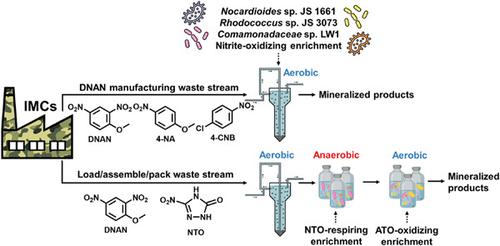当前位置:
X-MOL 学术
›
Biotechnol. Bioeng.
›
论文详情
Our official English website, www.x-mol.net, welcomes your feedback! (Note: you will need to create a separate account there.)
Designing bacterial consortia for the complete biodegradation of insensitive munitions compounds in waste streams
Biotechnology and Bioengineering ( IF 3.8 ) Pub Date : 2022-06-15 , DOI: 10.1002/bit.28160 Osmar Menezes 1 , Cameron Owens 2 , Erika E Rios-Valenciana 1 , Reyes Sierra-Alvarez 1 , Jim A Field 1 , Jim C Spain 2, 3
Biotechnology and Bioengineering ( IF 3.8 ) Pub Date : 2022-06-15 , DOI: 10.1002/bit.28160 Osmar Menezes 1 , Cameron Owens 2 , Erika E Rios-Valenciana 1 , Reyes Sierra-Alvarez 1 , Jim A Field 1 , Jim C Spain 2, 3
Affiliation

|
Insensitive munitions compounds (IMCs), such as 2,4-dinitroanisole (DNAN) and 3-nitro-1,2,4-triazol-5-one (NTO), are replacing conventional explosives in munitions formulations. Manufacture and use of IMCs generate waste streams in manufacturing plants and load/assemble/pack facilities. There is a lack of practical experience in executing biodegradation strategies to treat IMCs waste streams. This study establishes a proof-of-concept that bacterial consortia can be designed to mineralize IMCs and co-occurring nitroaromatics in waste streams. First, DNAN, 4-nitroanisole (4-NA), and 4-chloronitrobenzene (4-CNB) in a synthetic DNAN-manufacturing waste stream were biodegraded using an aerobic fluidized-bed reactor (FBR) inoculated with Nocardioides sp. JS 1661 (DNAN degrader), Rhodococcus sp. JS 3073 (4-NA degrader), and Comamonadaceae sp. LW1 (4-CNB degrader). No biodegradation was detected when the FBR was operated under anoxic conditions. Second, DNAN and NTO were biodegraded in a synthetic load/assemble/pack waste stream during a sequential treatment comprising: (i) aerobic DNAN biodegradation in the FBR; (ii) anaerobic NTO biotransformation to 3-amino-1,2,4-triazol-5-one (ATO) by an NTO-respiring enrichment; and (iii) aerobic ATO mineralization by an ATO-oxidizing enrichment. Complete biodegradation relied on switching redox conditions. The results provide the basis for designing consortia to treat mixtures of IMCs and related waste products by incorporating microbes with the required catabolic capabilities.
中文翻译:

设计用于完全生物降解废物流中不敏感弹药化合物的细菌联合体
不敏感弹药化合物 (IMC),例如 2,4-二硝基苯甲醚 (DNAN) 和 3-nitro-1,2,4-triazol-5-one (NTO),正在取代弹药配方中的常规炸药。IMC 的制造和使用会在制造工厂和装载/组装/包装设施中产生废物流。在执行生物降解策略来处理 IMC 废物流方面缺乏实践经验。这项研究建立了一个概念验证,即细菌聚生体可以设计用于矿化 IMC 和废物流中同时存在的硝基芳烃。首先,使用接种了诺卡氏菌属的好氧流化床反应器 (FBR) 对合成 DNAN 制造废物流中的 DNAN、4-硝基苯甲醚 (4-NA) 和 4-氯硝基苯 (4-CNB) 进行生物降解。JS 1661(DNAN 降解剂),红球菌sp。JS 3073(4-NA 降解剂)和Comamonadaceae sp。LW1(4-CNB 降解剂)。当 FBR 在缺氧条件下运行时,未检测到生物降解。其次,DNAN 和 NTO 在合成装载/组装/包装废物流中在顺序处理过程中被生物降解,包括: (i) FBR 中的好氧 DNAN 生物降解;(ii) 通过 NTO 呼吸富集将厌氧 NTO 生物转化为 3-amino-1,2,4-triazol-5-one (ATO);(iii) 通过 ATO 氧化富集的好氧 ATO 矿化。完全的生物降解依赖于切换氧化还原条件。该结果为设计联合体通过结合具有所需分解代谢能力的微生物来处理 IMC 和相关废物的混合物提供了基础。
更新日期:2022-06-15
中文翻译:

设计用于完全生物降解废物流中不敏感弹药化合物的细菌联合体
不敏感弹药化合物 (IMC),例如 2,4-二硝基苯甲醚 (DNAN) 和 3-nitro-1,2,4-triazol-5-one (NTO),正在取代弹药配方中的常规炸药。IMC 的制造和使用会在制造工厂和装载/组装/包装设施中产生废物流。在执行生物降解策略来处理 IMC 废物流方面缺乏实践经验。这项研究建立了一个概念验证,即细菌聚生体可以设计用于矿化 IMC 和废物流中同时存在的硝基芳烃。首先,使用接种了诺卡氏菌属的好氧流化床反应器 (FBR) 对合成 DNAN 制造废物流中的 DNAN、4-硝基苯甲醚 (4-NA) 和 4-氯硝基苯 (4-CNB) 进行生物降解。JS 1661(DNAN 降解剂),红球菌sp。JS 3073(4-NA 降解剂)和Comamonadaceae sp。LW1(4-CNB 降解剂)。当 FBR 在缺氧条件下运行时,未检测到生物降解。其次,DNAN 和 NTO 在合成装载/组装/包装废物流中在顺序处理过程中被生物降解,包括: (i) FBR 中的好氧 DNAN 生物降解;(ii) 通过 NTO 呼吸富集将厌氧 NTO 生物转化为 3-amino-1,2,4-triazol-5-one (ATO);(iii) 通过 ATO 氧化富集的好氧 ATO 矿化。完全的生物降解依赖于切换氧化还原条件。该结果为设计联合体通过结合具有所需分解代谢能力的微生物来处理 IMC 和相关废物的混合物提供了基础。


























 京公网安备 11010802027423号
京公网安备 11010802027423号